Her World Is a Letter: Vermeer’s Fascination With Writing Women
The largest Vermeer exhibition ever can be seen until 4 June 2023 at Amsterdam’s Rijksmuseum: twenty-eight paintings have been brought together from all over the world, seven of them for the first time for a Dutch audience. Author and art historian Gerdien Verschoor wrote a personal reflection on Vermeer’s work for us. In his paintings of women writing letters, Verschoor hears their pens scratching the paper in a world that is otherwise dead silent.
Now that the large Vermeer exhibition is in Amsterdam, I am inadvertently catapulted back in time. It’s September 2017, and it seems as though I’ve ended up at an exhibition of wondrous peephole dioramas. They light up against the darkness of the walls; glimpses of Dutch interiors captured in frames of sleek ebony or elegant gold.
It’s busy in the museum’s galleries on this last day of the major expo Vermeer and the Masters of Genre Painting in Dublin. I join in with the other visitors: dusky shadows whispering or silently making their way through the museum’s dimmed galleries. Despite the crowds, the magical lighting makes it seem as though one can be alone with each painting. I take my time getting lost inside each diorama, and there I find them: women playing an instrument, women freshening up in front of a mirror, women holding birdcages. Ladies are eating oysters, peeling apples, putting on and taking off stockings. A gentleman raises a glass. An infant is nursed. Someone cuddles a dog, takes a nap, reads a book. A broom leans against a wall somewhere, slippers are on the floor, keys are in a lock.
And then the letters! Letters are sealed, handed over, received. Letters are expected. They lay folded on the table, are opened, read, cherished, crumpled. One even lands on the floor. And letters are written, like here, in this Vermeer painting: Woman Writing a Letter, with her Maid.
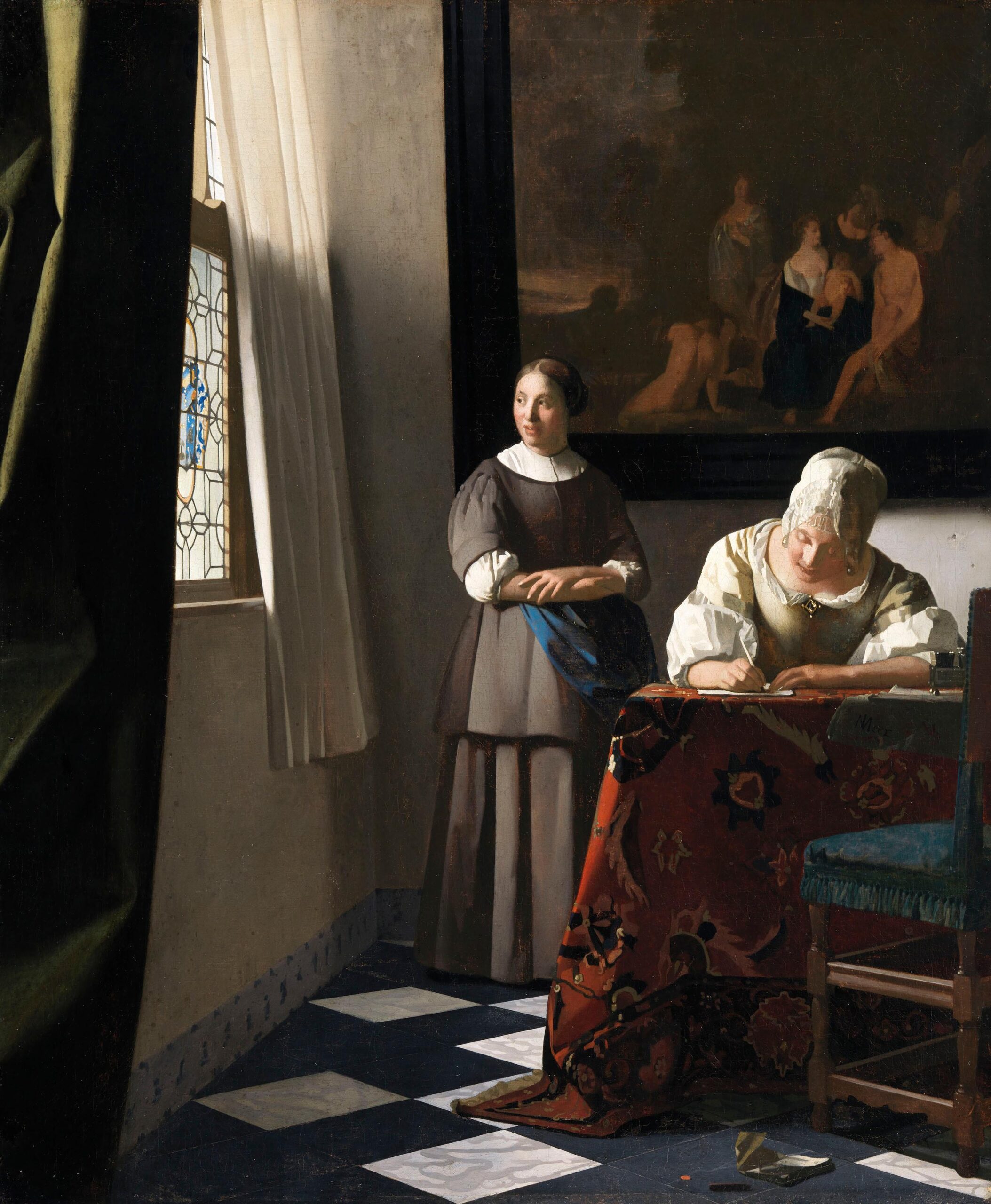 Johannes Vermeer, Woman Writing a Letter, with her Maid, circa 1670
Johannes Vermeer, Woman Writing a Letter, with her Maid, circa 1670National Gallery of Ireland, Dublin
She sits there, at the table, on the edge of the image and yet in the centre of the composition. A warm-red carpet with colourful patterns covers the table. There is a chair in front of the table, upholstered in blue, and not pushed underneath. On the black-and-white tiled floor, there is a crumpled letter and a broken wax seal. Behind her we see the maid, staring outside through the stained-glass window. Nearly the entire wall in the background is taken over by a large painting. I can’t quite make out the scene, but the catalogue helps me – it is Moses who has been found in his bulrush basket. To the left, over the full length of the room where we find ourselves with these two women, a dark curtain is pushed aside by an invisible hand.
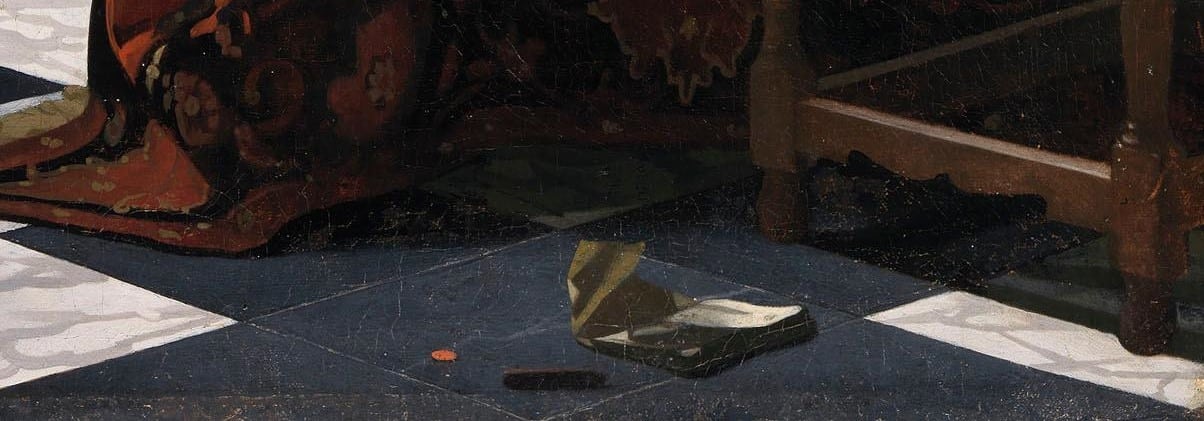 Detail from Vermeer's Woman Writing a Letter, with her Maid
Detail from Vermeer's Woman Writing a Letter, with her MaidThe woman at the table is oblivious. Her world is a letter. She is bent over a piece of paper, pen in hand, writing, writing and writing. Her attention is on her pen, on the paper. A blush has appeared on her cheeks. She has just crumpled a failed letter, which has landed on the tiled floor, next to the seal and stick of sealing wax. I imagine that someone outside is waiting for her words. The maid gazes silently at him. Soon, she will rush out, the letter in hand, safely sealed. She will give it to the recipient whom only she can see.
In praise of dreams
The Polish poet and Nobel Prize winner Wisława Szymborska loved the Old Masters. “In my dreams/I paint like Vermeer van Delft”, begins her poem ‘In Praise of Dreams’. She dreams and dreams and dreams. She dreams that she speaks fluent Greek – and not just with the living. In her dreams she drives a car that does what she wants it to do. She writes mighty epics. When she falls from the roof, she manages to tumble gently to the grass. She breathes under water, and after the war breaks out, she rolls over on her other side. She sees two suns and clear as day, a penguin. I walk through the exhibitions with the words of her poem on my mind. I dream.
Wisława Szymborska – In Praise of Dreams
In my dreams
I paint like Vermeer van Delft.
I speak fluent Greek
and not just with the living.
I drive a car
that does what I want it to do.
I am gifted
and write mighty epics.
I hear voices
as clearly as any venerable saint.
My brilliance as a pianist
would stun you.
I fly the way we ought to,
i.e., on my own.
Falling from the roof,
I tumble gently to the grass.
I’ve got no problem
breathing under water.
I can’t complain:
I’ve been able to locate Atlantis.
It’s gratifying that I can always
wake up before dying.
As soon as war breaks out,
I roll over on my other side.
I am a child of my age,
but I don’t have to be.
A few years ago
I saw two suns.
And the night before last a penguin.
clear as day.
From: Poems: New and Collected, 1957 – 1997, Ecco, 2000, translated by Stanislaw Baranczak and Clare Cavanagh.
You don’t have to look
What are all those women who are writing letters dreaming of? Did the Old Masters paint their dreams, perhaps? Behind them, on the walls? Are they dreaming of the bed hidden by curtains behind their desk? And of the man who is hiding in that bed? Are they dreaming of a child like Moses in his basket? Are they dreaming of a journey at sea? Or are they dreaming of each other – how they are corresponding? That they will finally meet? At this awe-inspiring and beautiful exhibition, I counted nine paintings of women who are reading or writing a letter – there are even more in the catalogue. At the Rijksmuseum, seven women with letters, painted by Vermeer, can be seen.
The carriages on the street, the barking dogs, the annoying cry of a baby in the distance – they’re oblivious to it all
Painted in Delft and Deventer, Haarlem or Amsterdam by Vermeer and his contemporaries, all those women writing letters have been dispersed throughout the world. From the intimacy of their Dutch living rooms, they have moved to large museum galleries in New York and Zürich, The Hague and Dresden, Dublin and Washington. And still, you can hear their pens scratching the paper in an otherwise dead-silent world. The carriages on the street, the barking dogs, the annoying cry of a baby in the distance – they’re oblivious to it all. The doors are closed, the curtains are drawn. The outside world only exists in the paintings and maps on the wall, but you don’t have to look. You are here alone with your pen, your letter. You decide. Something is about to happen. Something is about to change in your life because you are sitting here at the table with a pen in hand. You write and write and write.
Undivided attention
Vermeer found inspiration for this subject in Gerard ter Borch. His contemporary can be called the master of letter paintings: he made eighteen! Art historical research tells us that he was the first to come up with the subject, launching a phenomenal proliferation halfway through the seventeenth century. The prototype for the many letter writers that followed was his Woman Writing a Letter (1655-56), in the collection of the Mauritshuis. All the elements are already present: the woman and the pearls in her ears, the pen and the paper, the heavy tablecloth (which is shoved aside in this painting to make room for writing), the undivided attention to the writing.
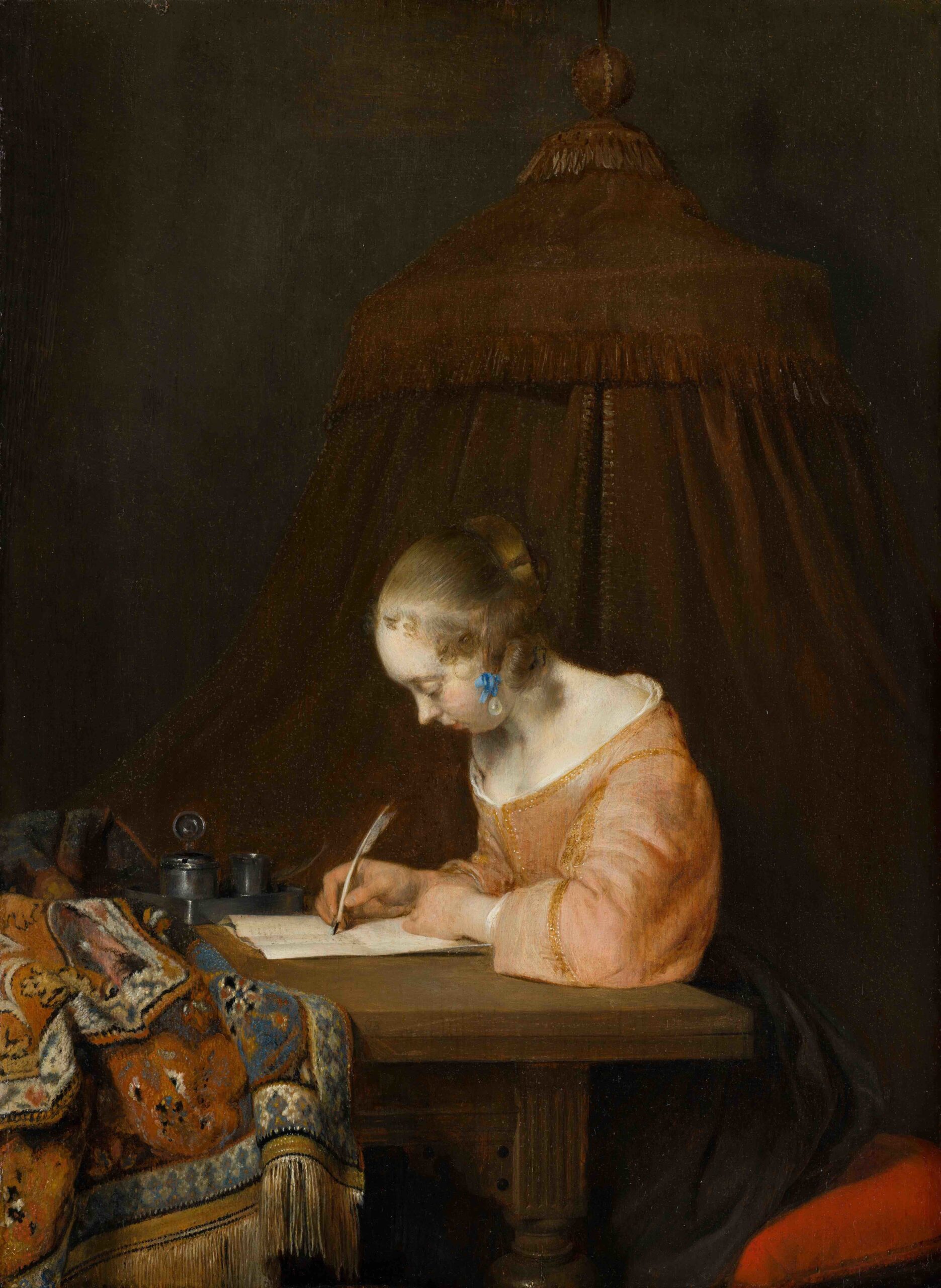 Gerard ter Borch, A Lady Writing, 1655-1656
Gerard ter Borch, A Lady Writing, 1655-1656Mauritshuis, The Hague
Vermeer must have been familiar with the painting (or a copy, or a copy of a copy, or a print). Just look at his A Lady Writing (circa 1665, National Gallery of Art, Washington): it strongly resembles Ter Borch’s work, and yet differs vastly. Vermeer’s lady has quickly pulled up a chair, there is a vivid blue carpet on the table, and whereas Ter Borch included a bed in the background, Vermeer opted for a dark painting. The woman has her quill pen at the ready, her hand is resting on the paper, her pearl necklace is strewn somewhat carelessly alongside. She has fun bows in her hair and oversized pearls dangle from her ears. Unlike in Ter Borch’s painting, the woman is not engrossed in writing the letter, but allows herself to be distracted by us. We look at her, and she looks back: a look that spans almost three centuries.
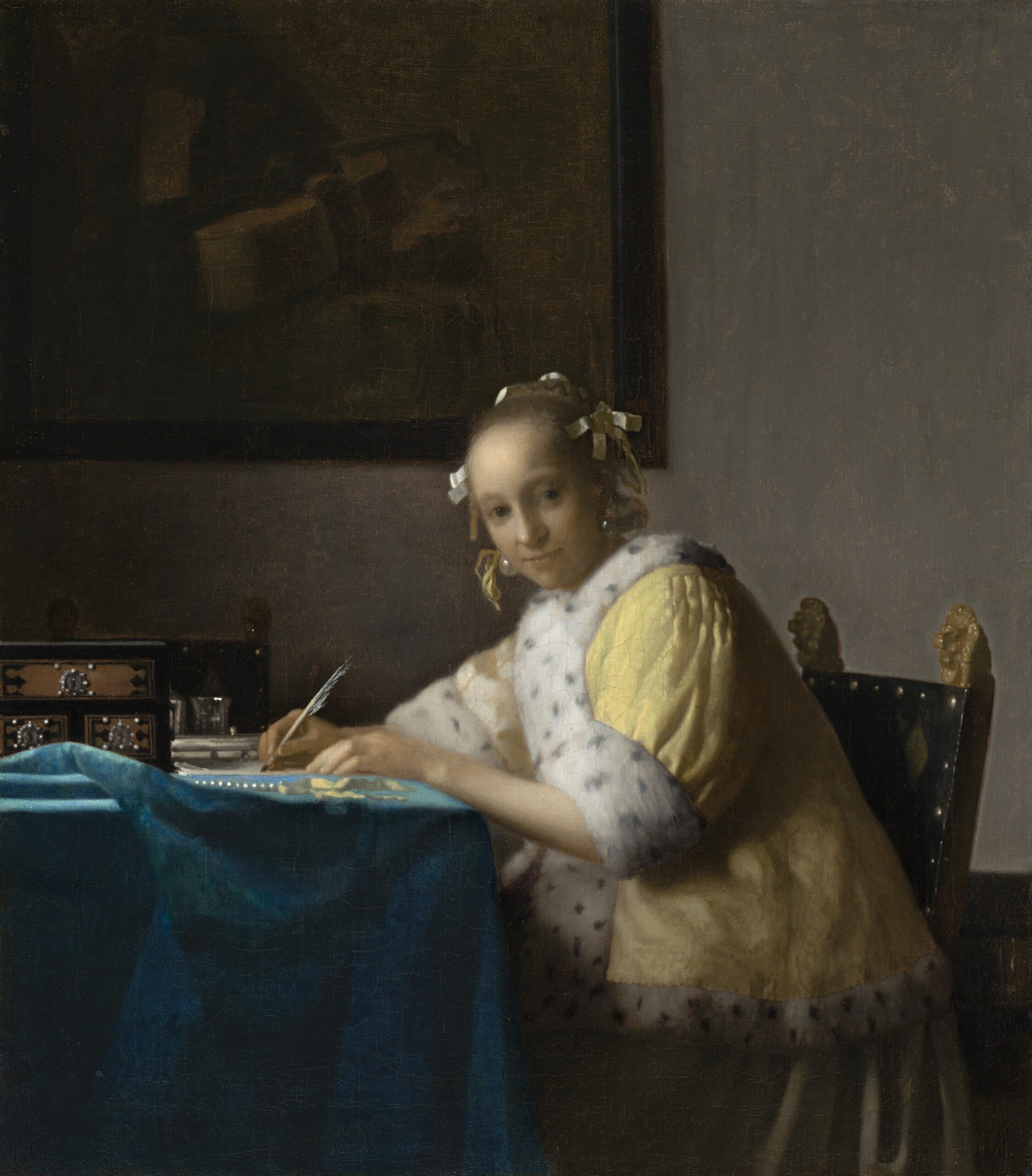 Johannes Vermeer, A Lady Writing, circa 1665
Johannes Vermeer, A Lady Writing, circa 1665National Gallery of Art, Washington
Gabriël Metsu also adopted the theme in his Elegant Lady Writing at her Desk
(1662-1664, Leiden Collection, New York): girl, letter, pen, the carpet haphazardly draped over the table. Metsu’s letter writer looks at us mischievously and seeks contact, her earrings dancing from her ears. She sits crookedly on her much too small chair. She hasn’t bothered to push the tablecloth aside. A dog comes running in. In the background there’s a painting of an indiscernible scene in a frilly golden frame.
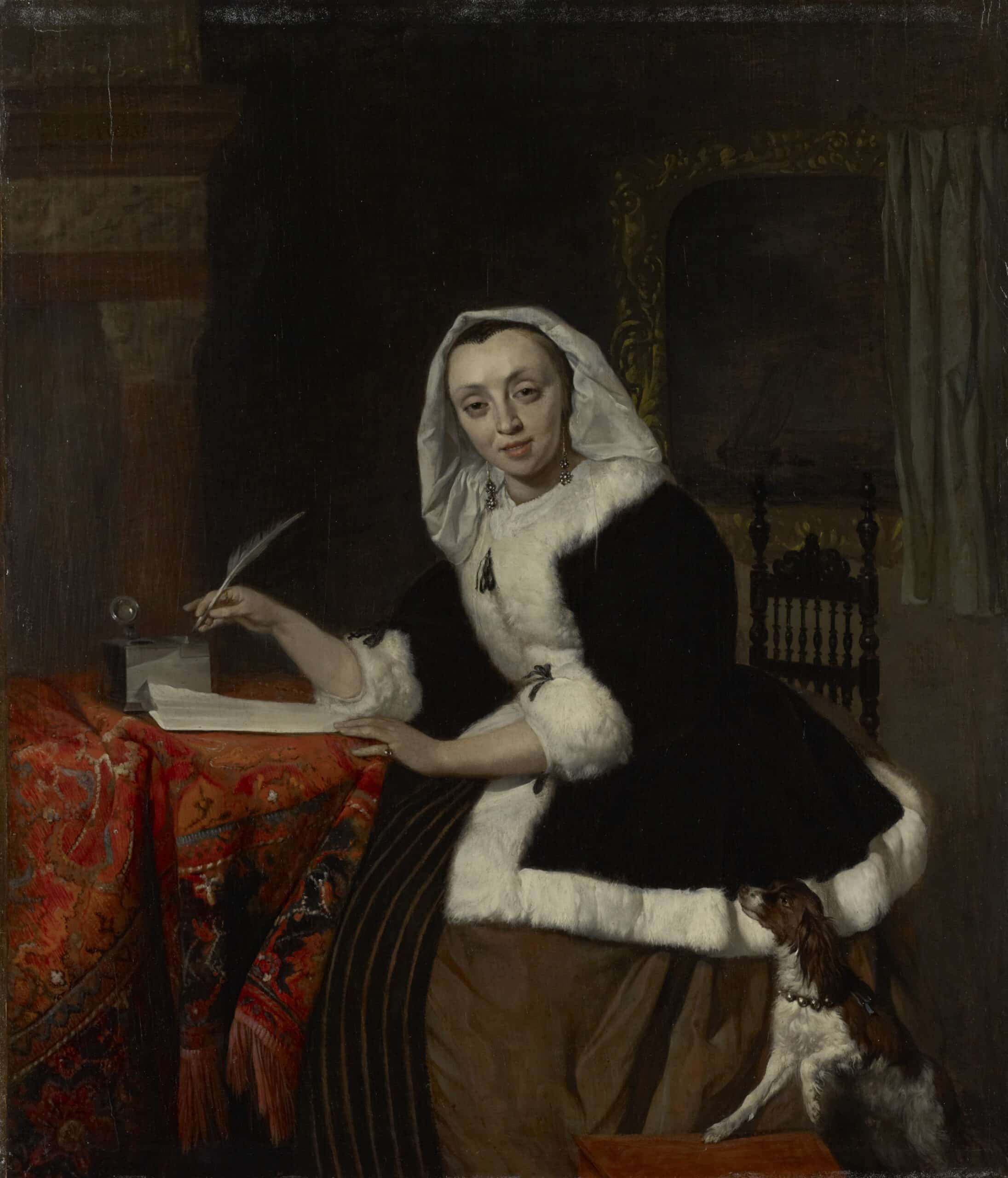 Gabriel Metsu, Elegant Lady Writing at her Desk, 1662-1664
Gabriel Metsu, Elegant Lady Writing at her Desk, 1662-1664The Leiden Collection, New York
The theme of women writing letters takes hold of Vermeer. Two years after A Lady Writing, he paints Mistress and Maid (circa 1667, Frick Collection, New York). She also wears a yellow jacket with fur trim. And she’s also distracted, though not by us. She looks at her maid, who hands her a letter and speaks. She’s taken aback.
Three years later, Woman Writing a Letter, with her Maid
was created. Although it’s the busiest of the three Vermeer letter writers discussed here – there’s a lot happening in the scene – it’s also the most serene.
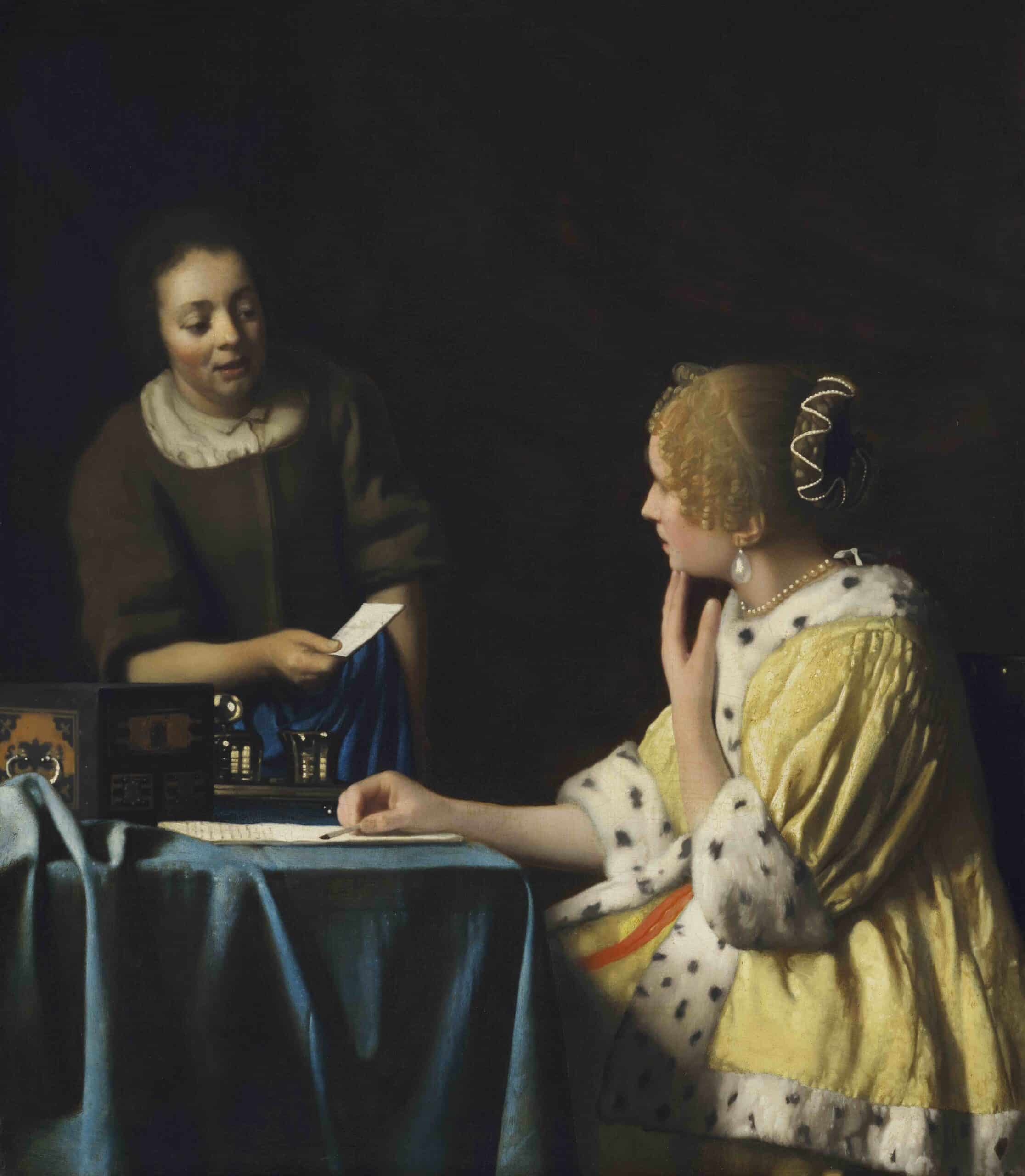 Johannes Vermeer, Mistress and Maid, circa 1667
Johannes Vermeer, Mistress and Maid, circa 1667Frick Collection, New York
Art thieves
A lot happened to the painting since it left Vermeer’s studio. After his death, his widow Catharina Bolnes gave the canvas to baker Hendrik van Buyten as collateral (she owed him six hundred and seventeen guilders and six stuivers). After various meanderings, the artwork was purchased in 1895 by gold and diamond magnate Alfred Beit (1853-1906), who was born in Hamburg and was living in South Africa. Through inheritance, the canvas ended up with his nephew and namesake (1903-1994), who housed his collection of paintings in the Russborough country house near Dublin. Unfortunately, the collection proved extremely popular with art thieves. In 1974, Woman Writing a Letter, with her Maid was stolen by the IRA along with eighteen other paintings. But the thieves’ joy was short-lived: the artworks were found a week later, and the Vermeer painting was only slightly damaged.
It’s an astonishing realisation: that a baker from Delft, a wealthy industrialist and art thieves once stood just as attentively in front of the painting as I am now
Twelve years later, on 12 May 1986, the canvas was stolen yet again, along with sixteen other paintings. It disappeared into the underworld. After years of international detective work and secret negotiations, the artworks were finally returned to Russborough in September of 1993. The owner bequeathed the Vermeer painting to The National Gallery of Ireland in Dublin. It’s an astonishing realisation: that a baker from Delft, a wealthy industrialist and art thieves once stood just as attentively in front of the painting as I am now.
A matter of light
In my dreams, I know why Vermeer rises above the rest. In my dreams, I can precisely explain how he works his magic. It’s a matter of light, of course; how the creases are painted on a jacket, the way in which a hand holds or puts down a pen, how you can tell that a maid is waiting for something. It’s the way in which he leaves out so much and yet manages to tell a story we can’t keep our eyes off of.
The woman doesn’t notice
It’s a hot day: of Vermeer’s three letter-writing women, she is the only one not wearing the yellow jacket with fur trim. Her white collar sits loosely on her bare neck. Her exposed forearms rest on the itchy tablecloth. The maid is growing more impatient as she waits. A corner of the tablecloth hangs untidily on the floor. The crumpled letter, the chair pushed aside, the busy painting in the background in which Moses is found in his basket. But the woman doesn’t notice a thing. She writes.
The maid has drawn the curtains a bit. She’s still looking outside. It appears as though she’s saying something. But now light dances into the room, light that shines on the woman writing a letter, rendering her almost transparent. The light paints her hand, her pen, her letter. The light paints her neck and her face. The light has taken over Vermeer’s brush and now paints sleeves and a paper hat. The woman herself has turned into paper. She has become her letter.
Literature












